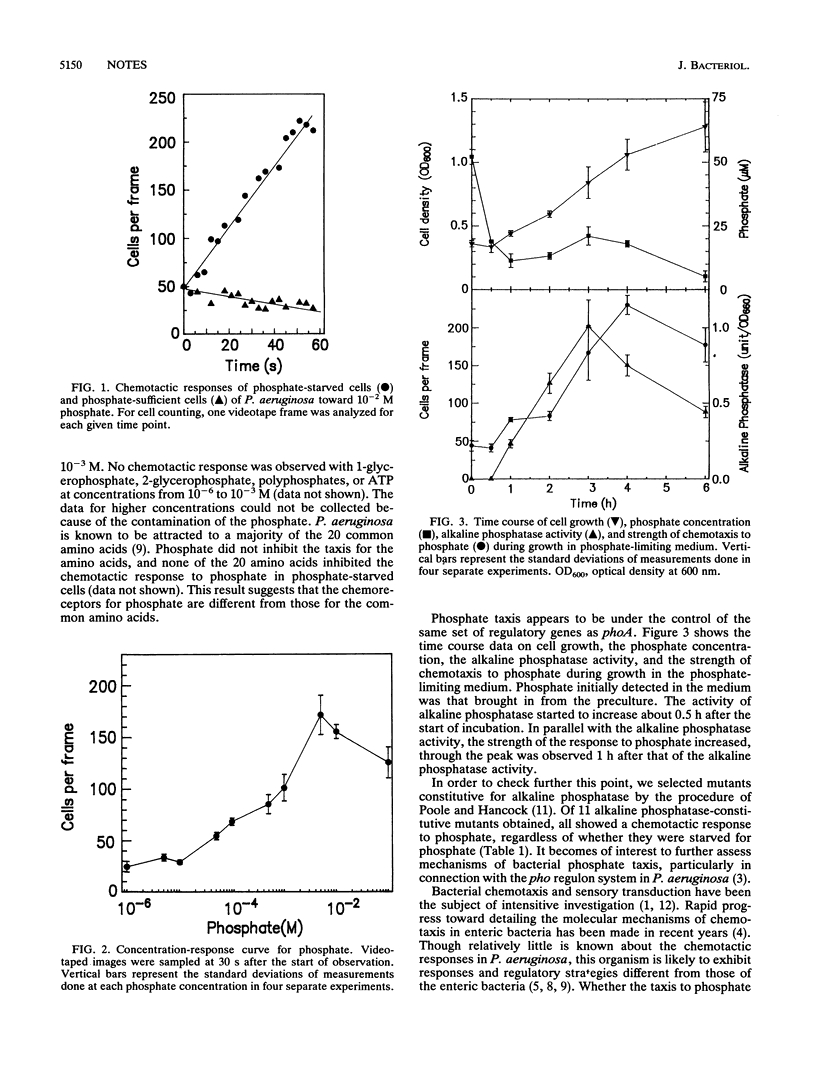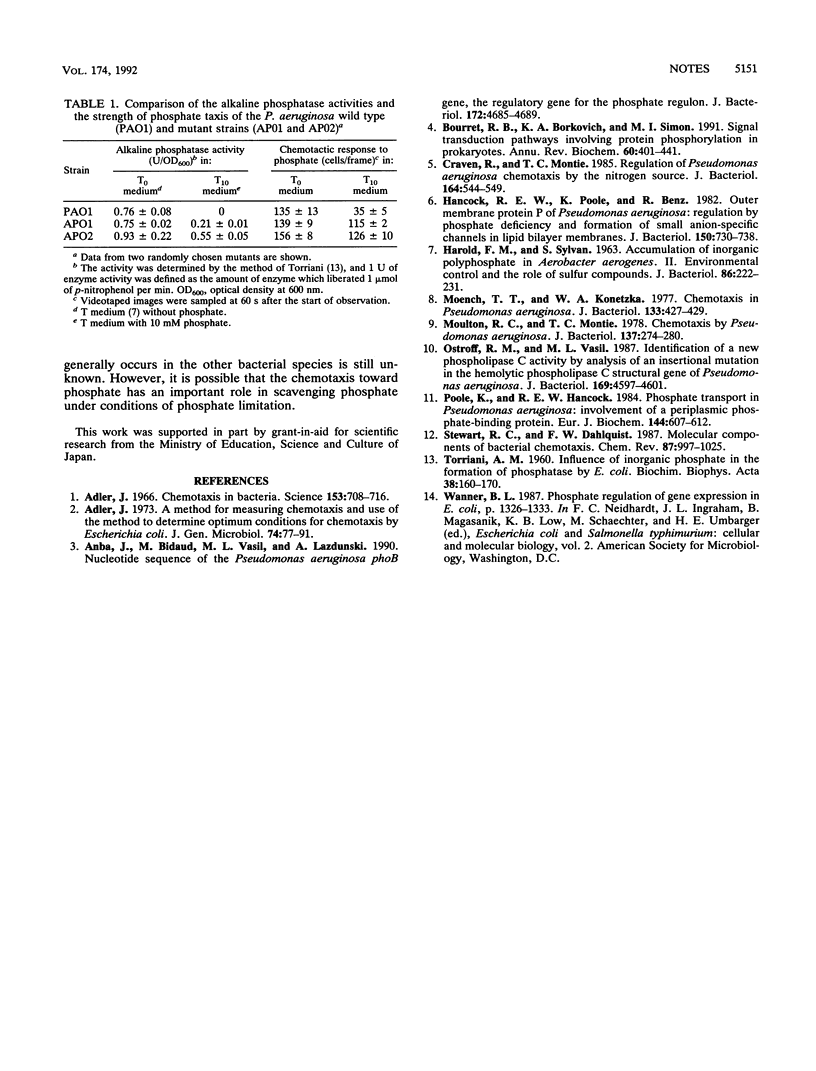Abstract
Pseudomonas aeruginosa was shown to be attracted to phosphate. The chemotactic response was induced by phosphate starvation. The specificity of chemoreceptors for phosphate was high so that no other tested phosphorus compounds elicited a chemotactic response as strong as that elicited by phosphate. Competition experiments showed that the chemoreceptors for phosphate appeared to be different from those for the common amino acids. Mutants constitutive for alkaline phosphatase showed the chemotactic response to phosphate regardless of whether the cells were starved for phosphate.
Full text
PDF


Selected References
These references are in PubMed. This may not be the complete list of references from this article.
- Adler J. A method for measuring chemotaxis and use of the method to determine optimum conditions for chemotaxis by Escherichia coli. J Gen Microbiol. 1973 Jan;74(1):77–91. doi: 10.1099/00221287-74-1-77. [DOI] [PubMed] [Google Scholar]
- Adler J. Chemotaxis in bacteria. Science. 1966 Aug 12;153(3737):708–716. doi: 10.1126/science.153.3737.708. [DOI] [PubMed] [Google Scholar]
- Anba J., Bidaud M., Vasil M. L., Lazdunski A. Nucleotide sequence of the Pseudomonas aeruginosa phoB gene, the regulatory gene for the phosphate regulon. J Bacteriol. 1990 Aug;172(8):4685–4689. doi: 10.1128/jb.172.8.4685-4689.1990. [DOI] [PMC free article] [PubMed] [Google Scholar]
- Bourret R. B., Borkovich K. A., Simon M. I. Signal transduction pathways involving protein phosphorylation in prokaryotes. Annu Rev Biochem. 1991;60:401–441. doi: 10.1146/annurev.bi.60.070191.002153. [DOI] [PubMed] [Google Scholar]
- Craven R., Montie T. C. Regulation of Pseudomonas aeruginosa chemotaxis by the nitrogen source. J Bacteriol. 1985 Nov;164(2):544–549. doi: 10.1128/jb.164.2.544-549.1985. [DOI] [PMC free article] [PubMed] [Google Scholar]
- GREEN D. E., JARNEFELT J., TISDALE H. D. Studies on the electron transport system. XIV. The isolation and properties of soluble cytochrome c1. Addendum. Biochim Biophys Acta. 1960 Feb 12;38:160–160. doi: 10.1016/0006-3002(60)91212-9. [DOI] [PubMed] [Google Scholar]
- HAROLD F. M., SYLVAN S. ACCUMULATION OF INORGANIC POLYPHOSPHATE IN AEROBACTER AEROGENES. II. ENVIRONMENTAL CONTROL AND THE ROLE OF SULFUR COMPOUNDS. J Bacteriol. 1963 Aug;86:222–231. doi: 10.1128/jb.86.2.222-231.1963. [DOI] [PMC free article] [PubMed] [Google Scholar]
- Hancock R. E., Poole K., Benz R. Outer membrane protein P of Pseudomonas aeruginosa: regulation by phosphate deficiency and formation of small anion-specific channels in lipid bilayer membranes. J Bacteriol. 1982 May;150(2):730–738. doi: 10.1128/jb.150.2.730-738.1982. [DOI] [PMC free article] [PubMed] [Google Scholar]
- Moench T. T., Konetzka W. A. Chemotaxis in Pseudomonas aeruginosa. J Bacteriol. 1978 Jan;133(1):427–429. doi: 10.1128/jb.133.1.427-429.1978. [DOI] [PMC free article] [PubMed] [Google Scholar]
- Moulton R. C., Montie T. C. Chemotaxis by Pseudomonas aeruginosa. J Bacteriol. 1979 Jan;137(1):274–280. doi: 10.1128/jb.137.1.274-280.1979. [DOI] [PMC free article] [PubMed] [Google Scholar]
- Ostroff R. M., Vasil M. L. Identification of a new phospholipase C activity by analysis of an insertional mutation in the hemolytic phospholipase C structural gene of Pseudomonas aeruginosa. J Bacteriol. 1987 Oct;169(10):4597–4601. doi: 10.1128/jb.169.10.4597-4601.1987. [DOI] [PMC free article] [PubMed] [Google Scholar]
- Poole K., Hancock R. E. Phosphate transport in Pseudomonas aeruginosa. Involvement of a periplasmic phosphate-binding protein. Eur J Biochem. 1984 Nov 2;144(3):607–612. doi: 10.1111/j.1432-1033.1984.tb08508.x. [DOI] [PubMed] [Google Scholar]


